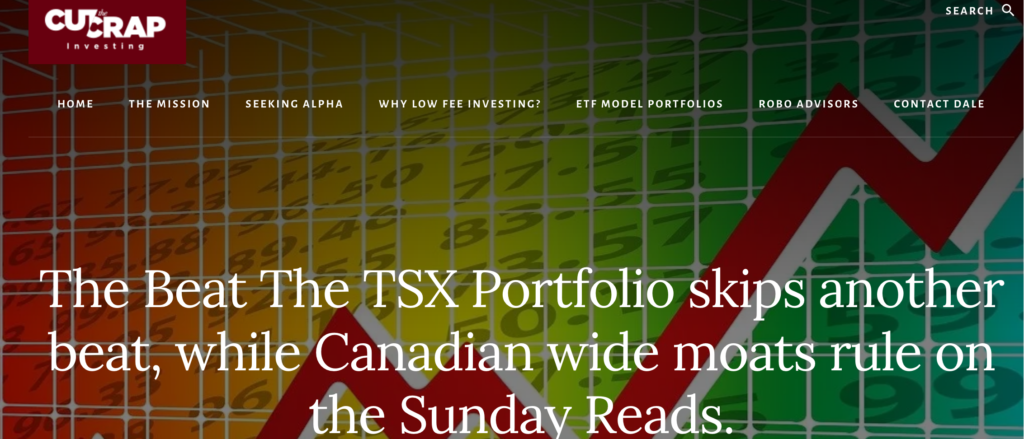By Dale Roberts, cutthecrapinvesting
Special to Financial Independence Hub
In this Sunday Reads we’ll begin with a look at the first half returns for the Beat The TSX Portfolio and the Canadian Wide Moat Portfolios. The Beat The TSX Portfolio is a pure value play, discovered by those big dividends. The Canadian Wide Moat Portfolio relies on the moats – a lack of competition. There are a few key oligopoly sectors in Canada. While both Canadian stock portfolio approaches have a nice history of beating the market, the BTSX is more volatile, while the Wide Moats are more low volatility by design. The BTSX Portfolio continues to struggle while the Wide Moats continue to best the market.
Here’s the updated post on The Beat The TSX Portfolio.
For the first half of 2024, it’s 6% vs 1.3% in favour of the passive TSX Composite.
And here’s the updated post for the Canadian Wide Moat Portfolios.
The wide moat portfolio has beat the TSX by some 1.6% annual over the last decade. That said, it has underperformed from 2023. I can still find no better model for the large cap Canadian space. It tracks closely to (but slightly outperforms) the BMO Low Volatility ETF – ZLB.TO.
Shareholder yield
I really liked this post and screen in the Globe & Mail (sub required). Companies that have a lot of free cash flow typically perform very well. They can buy back shares (increasing your ownership) and pay bigger and increasing dividends. We call that combination the shareholder yield. The screen also looked at valuation, quality and more. Here’s where it landed. It’s a nice sixpack …

And check out the buy back and dividend history for Canadian Natural Resources. My favourite oil and gas stock …
More on oil and gas …
The markets last week
The separation between Canadian markets and U.S. markets continued last week. Recession fears for Canada outweigh any giddiness for rate cuts. The TSX Composite was down 0.85% on Friday. Canada’s rising unemployment rate increased the odds of another rate cut in July. From the Globe & Mail …
Canada’s unemployment rate rose to a 29-month high of 6.4 per cent, data showed on Friday, highlighting that people might be losing jobs as the labour market struggles to absorb a rapidly swelling population.
The jobs report, which also showed that youth unemployment reached almost a decade high barring the pandemic years, prompted money markets to increase bets of a rate cut by the Bank of Canada this month to around 56 per cent from 40 per cent a day earlier.
Economists pointed out that the rising unemployment rate could be indicating that Canada is flirting with recession.
Roy Mendes of Desjardin added that lowering interest rates is the only way to soften the blow from upcoming mortgage renewals and keep any hope of a soft landing alive..
For the week, the S&P 500 gained 1.95%, the Nasdaq rose 3.5% pct, and the Dow climbed 0.66%. The TSX was up 0.37% for the week.
Last week I looked at sectors and stock market performance for the first half of 2024. We’re off to a very good start.
I Tweeted the success of the asset allocation ETFs in Canada …
More Sunday Reads
Dividend Hawk has the stock stories and Seeking Alpha blog posts of the week. We also shared some Pepsi and Telus dividends last week. Pepsi is one of my favourite defensive stocks (that I hold).
And it’s always an enriching financial journey at Banker on Wheels. In the mix is a very good post that frames the last 100 years of investing.
A century of diversification. Was it worth it?
The annualised cumulative total returns over the full sample were 3.3% for Treasury bills, 4.6% for Treasury bonds, 6.8% for US corporate bonds and 10.4% for American stocks. This hierarchy of average returns is consistent across shorter investment horizons and aligns with the market risk of each asset class, measured by annual-return volatility (approximately 3%, 8%, 8% and 19%, respectively).
We take on more risk for the potential of greater returns. You can learn some of the investment basics in this Cut The Crap Investing video on YouTube.
And then check out these simple ETF Portfolios for Canadian investors.
Growth concentration in U.S. stocks
Also in the Banker post, the stocks driving the S&P 500 in 2024.

We hold 4 of the top 10, with very good exposure in Nvidia by way of CHPS.TO.
But concentration in the U.S. is nothing new …
Bob at Tawcan offers some thoughts on investing, and life.
Findependence Hub offers a guide to calculating your retirement needs.
A must retirement read: We’re retiring during the dot com crash.
Dan at Stocktrades looks at ETFs that cover the TSX.
Thanks for reading ..
You can follow this blog, it’s free. Simply enter your email address in the Subscribe area and new posts will be delivered to your inbox.
Use Contact Dale to reach out. I will reply.
 Dale Roberts is the owner operator of the Cut The Crap Investing blog. A former ad guy and investment advisor and occasional columnist for MoneySense, Dale helps Canadians say goodbye to paying some of the highest investment fees in the world. This blog originally appeared on Cut the Crap Investing on July 7, 2024 and is republished on the Hub with permission.
Dale Roberts is the owner operator of the Cut The Crap Investing blog. A former ad guy and investment advisor and occasional columnist for MoneySense, Dale helps Canadians say goodbye to paying some of the highest investment fees in the world. This blog originally appeared on Cut the Crap Investing on July 7, 2024 and is republished on the Hub with permission.


